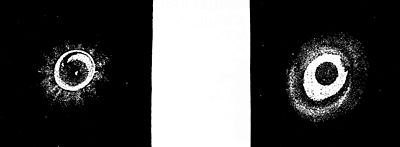dark spaces; the third is without any nucleus, but shows a well-defined ring of light.
The highest type of nebulae are certainly the stellar nebulæ, in which a tolerably well-defined bright star is surrounded by a completely rounded disk or faint atmosphere of light, which sometimes fades away gradually into space, at other times terminates abruptly with
| Fig. 14. | Fig. 15. | ||
 | |||
| Planetary Annular Nebula With Two Stars. | Planetary Nebula. | ||
a sharp edge. Figs. 16 and 17 exhibit the most striking of these very remarkable stellar nebulæ: the first is surrounded by a system of rings like Saturn, with the thin edge turned toward us; the second is a veritable star of the eighth magnitude, and is not nebulous, but is surrounded by a bright luminous atmosphere perfectly concentric. To the right of the star is a small dark space, such as often occurs in these nebulæ, indicating, perhaps, an opening in the surrounding atmosphere.
We have now passed in review all that is at present known of the nebulæ, so far as their appearance and form have been revealed by the largest telescopes. The information as yet furnished by the spectroscope on this subject is certainly much less extensive, but is nevertheless
| Fig. 16. | Fig. 17. | |
 | ||
| Planetary Nebula. | Stellar Nebula. | |
of the greatest importance, since the spectroscope has power to reveal the nature and constitution of these remote heavenly bodies. It must here again be remembered that the character of the spectrum not only indicates what the substance is that emits the light, but also

